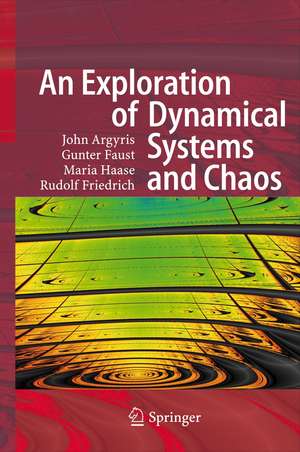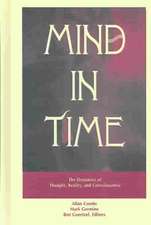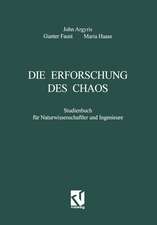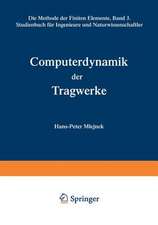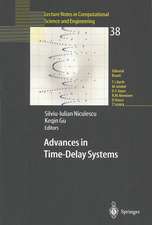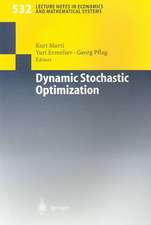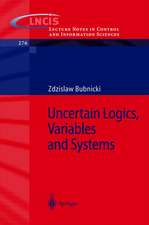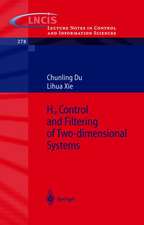An Exploration of Dynamical Systems and Chaos: Completely Revised and Enlarged Second Edition
Autor John H. Argyris, Gunter Faust, Maria Haase, Rudolf Friedrichen Limba Engleză Hardback – 11 mai 2015
This volume is a completely revised and enlarged second edition which comprises recently obtained research results of topical interest, and has been extended to include a new section on the basic concepts of probability theory. A completely new chapter on fully developed turbulence presents the successes of chaos theory, its limitations as well as future trends in the development of complex spatio-temporal structures.
"This book will be of valuable help for my lectures" Hermann Haken, Stuttgart
"This text-book should not be missing in any introductory lecture on non-linear systems and deterministic chaos" Wolfgang Kinzel, Würzburg
“This well written book represents a comprehensive treatise on dynamical systems. It may serve as reference book for the whole field of nonlinear and chaotic systems and reports in a unique way on scientific developments of recent decades as well as important applications.” Joachim Peinke, Institute of Physics, Carl-von-Ossietzky University Oldenburg, Germany
| Toate formatele și edițiile | Preț | Express |
|---|---|---|
| Paperback (1) | 713.56 lei 6-8 săpt. | |
| Springer Berlin, Heidelberg – 4 noi 2016 | 713.56 lei 6-8 săpt. | |
| Hardback (1) | 801.79 lei 6-8 săpt. | |
| Springer Berlin, Heidelberg – 11 mai 2015 | 801.79 lei 6-8 săpt. |
Preț: 801.79 lei
Preț vechi: 977.79 lei
-18% Nou
Puncte Express: 1203
Preț estimativ în valută:
153.44€ • 159.86$ • 127.58£
153.44€ • 159.86$ • 127.58£
Carte tipărită la comandă
Livrare economică 08-22 februarie 25
Preluare comenzi: 021 569.72.76
Specificații
ISBN-13: 9783662460412
ISBN-10: 3662460416
Pagini: 879
Ilustrații: XXII, 865 p. 400 illus., 2 illus. in color.
Dimensiuni: 155 x 235 x 53 mm
Greutate: 1.41 kg
Ediția:2015
Editura: Springer Berlin, Heidelberg
Colecția Springer
Locul publicării:Berlin, Heidelberg, Germany
ISBN-10: 3662460416
Pagini: 879
Ilustrații: XXII, 865 p. 400 illus., 2 illus. in color.
Dimensiuni: 155 x 235 x 53 mm
Greutate: 1.41 kg
Ediția:2015
Editura: Springer Berlin, Heidelberg
Colecția Springer
Locul publicării:Berlin, Heidelberg, Germany
Public țintă
ResearchCuprins
Descriptive synopsis of the text.- Mathematical introduction to dynamical systems.- Dynamical systems without dissipation.- Dynamical systems with dissipation.- Local bifurcation theory.- Convective flow: Benard problem.- Routes to chaos.- Turbulence.- Computer experiments.
Recenzii
“Familiarity with ideas and tools presented here is of doubtless use for all those who apply methods of the theory of dynamical systems to various problems in science and technology. I expect the book to find its readership basically as an introduction to nonlinear dynamics for undergraduate students of natural sciences, but also as a general reference work for researchers confronted with the need to understand dynamical mechanisms behind the phenomena which they encounter in their experiments and numerical simulations.” (Mikhail Zaks, Mathematical Reviews, May, 2016)
Textul de pe ultima copertă
This book is conceived as a comprehensive and detailed text-book on non-linear dynamical systems with particular emphasis on the exploration of chaotic phenomena. The self-contained introductory presentation is addressed both to those who wish to study the physics of chaotic systems and non-linear dynamics intensively as well as those who are curious to learn more about the fascinating world of chaotic phenomena. Basic concepts like Poincaré section, iterated mappings, Hamiltonian chaos and KAM theory, strange attractors, fractal dimensions, Lyapunov exponents, bifurcation theory, self-similarity and renormalisation and transitions to chaos are thoroughly explained. To facilitate comprehension, mathematical concepts and tools are introduced in short sub-sections. The text is supported by numerous computer experiments and a multitude of graphical illustrations and colour plates emphasising the geometrical and topological characteristics of the underlying dynamics.
This volume is a completely revised and enlarged second edition which comprises recently obtained research results of topical interest, and has been extended to include a new section on the basic concepts of probability theory. A completely new chapter on fully developed turbulence presents the successes of chaos theory, its limitations as well as future trends in the development of complex spatio-temporal structures.
"This book will be of valuable help for my lectures" Hermann Haken, Stuttgart
"This text-book should not be missing in any introductory lecture on non-linear systems and deterministic chaos" Wolfgang Kinzel, Würzburg
“This well written book represents a comprehensive treatise on dynamical systems. It may serve as reference book for the whole field of nonlinear and chaotic systems and reports in a unique way on scientific developments of recent decades as well as important applications.” Joachim Peinke, Institute of Physics, Carl-von-Ossietzky University Oldenburg, Germany
This volume is a completely revised and enlarged second edition which comprises recently obtained research results of topical interest, and has been extended to include a new section on the basic concepts of probability theory. A completely new chapter on fully developed turbulence presents the successes of chaos theory, its limitations as well as future trends in the development of complex spatio-temporal structures.
"This book will be of valuable help for my lectures" Hermann Haken, Stuttgart
"This text-book should not be missing in any introductory lecture on non-linear systems and deterministic chaos" Wolfgang Kinzel, Würzburg
“This well written book represents a comprehensive treatise on dynamical systems. It may serve as reference book for the whole field of nonlinear and chaotic systems and reports in a unique way on scientific developments of recent decades as well as important applications.” Joachim Peinke, Institute of Physics, Carl-von-Ossietzky University Oldenburg, Germany
Caracteristici
Unrivaled textbook about all facets of chaos theory and dynamical systems Exceeds by far a usual textbook including a variety of examples, solutions, pictures and simulations Comprehensive and detailed textbook leading the student into the middle of chaos theory and dynamical systems research
